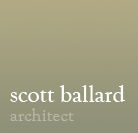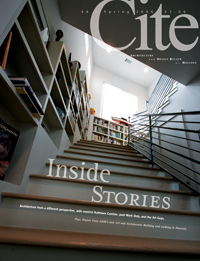Corbusier’s Scupper
From Chandigarh to Colquitt Court, with a little imagination
Interview by Terrence Doody
This interview originally appeared in CITE, Spring 2006.
A few years back, native Houstonian Judy Chapman was living a traditional River Oaks life in a traditional River Oaks house on Stanmore. Then she decided she needed a change. She wanted a house that better reflected who she was, that fit with the woman she had become, not the woman she had been. Working with architect Scott Ballard, Chapman set out to build “rooms of her own.” The result was like nothing she had ever lived in: a U-shaped building enclosing a side court, with metal siding, polished concrete floors, and windows that Chapman opens to seasonal breezes. It was definitely not a River Oaks traditional. Last summer, Terry Doody, who has known Chapman for 25 years, sat down with her and Ballard to ask just how somebody matches a house to a personality.
Cite: Judy, why a house like this, at this time in your life?
Chapman: I had always wanted to build a house. And one day I realized that I was approaching 60 and wasn’t getting any younger or any richer. Sixty is the only birthday that has ever given me pause. My River Oaks friends thought I was nuts.
Cite: What were your first ideas, your specifications?
Chapman: When we started I didn’t want to tell Scott too much. I looked at it as designing a functional piece of art, and I didn’t have too many practical considerations, because it was just me living here. There was a real sense of freedom doing it at this stage of my life.
Ballard: When we first met, you brought with you a picture of a house you liked. Northeastern style. It was striking, although restrained. Then everything you said after that was a clue to me that you wanted something different. What we ended up with was not restrained at all.
Chapman: I had no idea what the house would look like, but it had to feel right, and I wanted to see the outdoors. At our second meeting, which was actually a couple of years later, after interruptions and trying to find a property to build on, Scott started asking me all these questions that I didn’t have answers to.
I did tell him I wanted a contemporary house with windows, bookshelves, fireplaces. I wanted a “live-in” kitchen with a table and a sitting area, where I now have the television. I wanted my laundry room downstairs and a bar. An aging friend of mine told me that I had to have a powder room at the back of the house, off the kitchen, in addition to the one at the front, “because when you get old, you have to use the bathroom every time you turn on the water.”
I also wanted the master bedroom on the front and upstairs, so I could sleep with the windows open. I realized I could do here what I have done at the summer house I rented in Maine, but just at a different time of year.
Ballard: We started with three completely different floor plans for discussion purposes and evolved into a totally different plan — a U-shaped house, with an interior atrium at the focal point, with maximum exterior wall space for the greatest amount of natural light, and places on the inside to hang Judy’s art. We started in a fairly conventional way, but when you mentioned the metal siding, I knew we could widen our explorations. I thought the small study models really turned you on to the excitement of doing something different, more sculptural.
Chapman: I’m very visual. The house had to look right.
Cite: First it had to feel right and then look right? Is this place more tactile or visual?
Chapman: Both — it’s the emotion of the place, my emotion, that’s what I feel.
Cite: Did you two have any conflicts? Any dead ends?
Chapman: We didn’t really have any! I never felt Scott had any desires of his own except to please me…
Cite: Does the AIA know about this, Scott? Does your wife?
Chapman: I did suggest as we went along that a third-story library would be cool. Scott said we couldn’t afford it and went on to design a stairwell library, which is a real surprise, my favorite feature of the house.
Ballard: I went to the University of Texas and was educated as an engineer and an architect both. I actually enjoyed the engineering part more — the way things work. The client’s assignment and the limits of the budget are for me the artistic challenge. Not any “signature” look. After we decided on the “li-stairy” and I suggested we put your office under the stairs, you were on board immediately.
Chapman: I wanted a desk in a space that could be completely closed off. I’m neat about everything but my desk. The office was going to go upstairs, but we changed that during the framing.
Cite: During the framing? Are decisions and new directions like this, at this stage, normal?
Ballard: Normally you try to make all the decisions before construction, because changes during construction usually come with a high price tag. I try to take advantages of opportunities to make “free” changes, however, which can be done if the owner and architect are actively involved during framing and can catch things early enough.
Chapman: I was there every day and I could say anything to Scott. Also, the builder, Allan Edwards, was very cooperative. I even added two windows in the master bedroom after the framing was done. I just walked into the room and wanted to see through the wood to the outside.
Ballard: My feeling is that the whole process is always all collaboration. Judy might not be able to tell me what she wants in architectural terms, but she will know it when you show it to her. She gives me her program in terms of rooms and budget, but throughout the whole process I am learning what she wants exactly and what she’s open to consider. She is learning of the possibilities of self-expression, and I am thinking dimly of how the evolving plan will mass out as a structure.
Chapman: The empty shape of this house is finally Scott’s idea.
Ballard: But it is very important to me that I am never in the position of trying to force an idea on a client. I try to give them choices, between what they might think they wanted and something that might be more architecturally interesting.
Cite: Judy, when I first saw this house in its finished state, I didn’t think it “looked like” you at all. This house is cool, hard edged, monochromatic. You are warm, plush, and colorful.
Chapman: Not cool and monochromatic. I say calm and peaceful, which are things I never had in my life until my late fifties. I would say the house reflects my inner self at this time in life. I also feel it’s warm and inviting. My friends have said so too; they feel that my things make it warm. The clay artist who designed the tile and sink in the guest bath, Le Berth Lammers, and Gertrude Barnstone, who did the screens on the front door and fireplaces, they added a lot. And so did Steve Dvorak, who went to Rice, who did the fireplace surrounds.
Cite: And the house number is in violet neon. But you have told me that you painted the inside of the garage periwinkle for the days you might feel in sensory deprivation.
Chapman: Yes, I did! But this house feels energizing to me, a real deliberate transition into what Scott called earlier the “unforeseen.” I felt I finally had the courage to build the house I wanted and to hell with what others thought.
Cite: What do others think now?
Chapman: Well, my family really likes it a lot. My severest critic now says she could live here, but another old friend calls it a “tin shack.”
Cite: Do you think of the light in this house as a color? As I sit here and get used to looking at the whole place, the tones of this room come out, emerge, like the blacks and the whites in an Ansel Adams photo. Is that fair?
Ballard: I think so too.
Chapman: As you can see on the walls, I love black and white photography.
Cite: The textures of the wood, the fabrics, the stone surfaces are still a muted palette, just richer than I first thought. Cool and peaceful but not monotonous. Maybe that’s what is calm and energizing both. Has living her changed you?
Chapman: I have become a gardener. But this house is a sign of changes already started in me, not their cause. I love looking out these windows. The fact that I can see through the house, from the kitchen in the back, across the atrium, and out through the living room windows to the house across the street, is really cool. And my bedroom window lets me watch the sky turn, the light change, as I’m in bed. The blinds pull up from the bottom, not down.
Cite: What’s the neighborhood beyond the windows like?
Chapman: It’s better than anywhere else I have ever lived! Its name is Colquitt Court, and it was built as a small, blue-collar subdivision in the 1930s. The little houses on Richmond that are now all shops were part of the original development. The neighbors are fabulous, and I’ve become the head of our civic association.
Cite: And it is all because you have these windows! This story ever has a moral: Civic responsibility grows from your eyes on the street. One final thing — tell me more about the atrium. It’s a jungle out there.
Ballard: The atrium sits right across from the sliding-grass door/window on the stairs’ landing, so the air really moves through here. It creates the house’s chimney.
Cite: Does water run in? Those plants have loved the rain.
Ballard: The roofs are tilted to conduct the water through the scupper into the pool and keep it running away from the house.
Chapman: I wanted a round pool; I’d seen a picture of one. But the house shifted a little and a round pool would have been too big.
Cite: What’s a scupper?
Ballard: The extension of the gutter. I showed Judy a picture I took of the scupper Corbusier designed for his State House in Chandigarh, and she loved it. She always chose, as I said, the most adventurous and exciting option. You couldn’t sk for a better client.
Cite: So Corbusier’s scupper has come to Colquitt Court. And Judy’s smiling. I think we can stop here.

